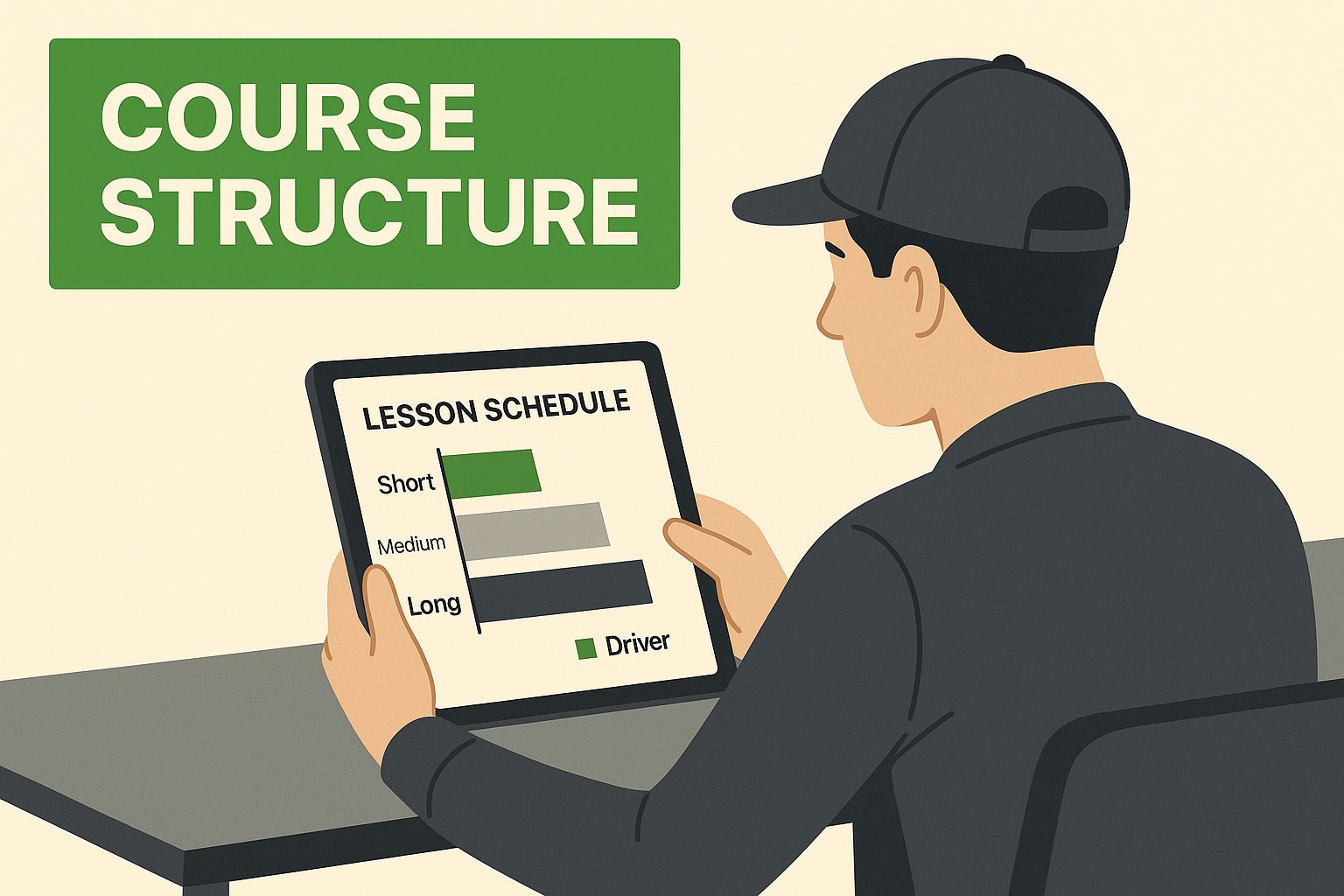What Makes Semi-Intensive Driving Courses Different
Imagine learning to drive is like learning a musical instrument. Practicing once a week might keep you vaguely familiar with the notes, but you won't develop the fluidity and muscle memory you need to really play. Cramming all your practice into a single, intense week, on the other hand, can feel overwhelming and like trying to learn an entire concerto in a day.
Semi-intensive driving courses offer a happy medium. Think of them as regular band practice. These courses typically condense your learning into a period of two to four weeks, allowing for consistent practice and skill development without the pressure of an intensive course. For instance, you might have 2-4 hour lessons several times a week. This frequency helps solidify your skills and build confidence much faster than scattered weekly lessons.
This approach also recognizes that everyone learns differently. It’s perfect for people who find weekly lessons too slow but aren't quite ready for the intensity of a crash course. It offers a more flexible schedule than intensive programs, which often require a full-day commitment. Instructors can tailor their teaching to a sustained learning pace, focusing on building a solid foundation and a deep understanding of driving techniques.
This balanced approach has become increasingly popular, reflecting a growing demand for effective and adaptable learning options. In fact, the UK driving school industry has seen significant growth, with a Compound Annual Growth Rate (CAGR) of 5.2% between 2019 and 2024. The industry is projected to reach £756.1 million in revenue by 2024. Discover more insights on the driving instruction industry. This growth underscores the demand for flexible and effective learning, like what semi-intensive courses provide. Ultimately, this balanced approach produces more confident and capable drivers.
Why Your Brain Loves The Semi-Intensive Approach

Learning to drive? Think of it like building a house. You wouldn't pour the foundation one day and then wait a week to frame the walls. That’s kind of how traditional weekly driving lessons can feel: a bit stop-start and lacking flow. Semi-intensive driving courses offer a different approach, providing the consistent building blocks your brain thrives on.
They leverage the power of spaced repetition, a fundamental learning principle. Spaced repetition gives your brain the breathing room it needs to absorb new information and convert it into long-term memory.
This consistent practice also allows your muscle memory to develop naturally. Imagine learning a dance routine. Practicing it regularly over a few days will ingrain those moves far more effectively than scattered practice sessions weeks apart.
A semi-intensive driving course works similarly, reinforcing skills through regular practice and promoting better retention. Consistent practice with maneuvers like parallel parking over a shorter period builds genuine, lasting skill.
Building Confidence and Avoiding Overwhelm
Semi-intensive courses also address the common issue of information overload. While intensive courses can feel like trying to drink from a firehose, a semi-intensive approach offers a more manageable flow of information.
This gentler pace reduces stress and allows learners to process information more effectively. This is especially helpful for nervous drivers who need time to build confidence behind the wheel.
They can solidify their skills at a comfortable pace without feeling rushed, leading to a more positive and productive learning experience. This steady, consistent practice helps avoid the "forgetting curve" often experienced with weekly lessons, where learners may forget crucial skills between sessions.
Semi-intensive courses keep the learning momentum high and prevent skills from fading. This consistent rhythm keeps you engaged and confident, resulting in a smoother, less stressful learning journey. It's the "Goldilocks" method – not too slow, not too fast, just right for developing lasting driving skills.
The Real Comparison: Weekly vs. Semi-Intensive vs. Intensive

The infographic above shows a learner driver reviewing their semi-intensive course structure. It highlights the organized, planned approach these courses offer, mapping out progress and building confidence. This structured learning journey gives learners a clear path to their driving test. Let's see how this compares to other learning styles.
Weekly Lessons: A Slow Burn
Imagine watering a plant just once a week. It might survive, but it won't flourish. Weekly lessons offer flexibility, which is great for busy schedules. However, the gaps between sessions often lead to inconsistent progress and the dreaded "forgetting curve". This can stretch out your learning period, potentially costing you more in the long run.
Intensive Driving Courses: Drinking From a Firehose
On the other end of the spectrum are intensive driving courses, sometimes called crash courses. These are like drinking from a firehose – a flood of information in a very short time. This condensed format works well for learners who thrive under pressure and need quick results. Check out this resource for more information on crash courses: crash driving course. However, the intensity can be overwhelming for some, and it may not give your new skills enough time to truly sink in.
Semi-Intensive Driving Courses: The Goldilocks Approach
Semi-intensive driving courses offer a happy medium—the "Goldilocks" approach. They provide the consistent learning momentum of intensive courses but at a more manageable pace. This gives you ample time to practice and hone your skills without feeling overwhelmed. This balanced approach caters to a broader range of learning styles, allowing you to progress confidently and steadily towards your driving test.
To help you visualize the differences, here’s a comparison table:
Driving Course Types: Complete Comparison
A detailed comparison of weekly lessons, semi-intensive, and intensive driving courses covering duration, frequency, cost, and suitability.
| Course Type | Duration | Lesson Frequency | Best For | Average Cost Range |
|---|---|---|---|---|
| Weekly Lessons | Months | Weekly | Learners with flexible schedules, prefer gradual learning | Lower |
| Semi-Intensive Course | Weeks | Several times a week | Learners seeking a balance of speed and absorption | Mid-range |
| Intensive Course | Days | Daily | Learners needing rapid results, comfortable with intense learning | Higher |
As you can see, each course type offers a different learning experience to suit individual needs and preferences. Choosing the right type is key to a successful and enjoyable learning journey.
Is A Semi-Intensive Course Right For You?
Not every learner thrives in the same environment. Some people flourish with daily lessons, absorbing information like a sponge. Others prefer a more gradual approach, like savoring a fine wine rather than gulping it down. A semi-intensive driving course caters to this latter group, offering a balanced approach.
Think of learning to drive like building a house. An intensive course is like trying to build the whole thing in a weekend – stressful and overwhelming. A semi-intensive course, however, allows you to build at a comfortable pace, laying a few bricks each day. This steady approach helps build a solid foundation of skills and confidence.
This style is especially beneficial for nervous learners. Imagine trying to learn a complex musical piece all at once. It's much easier to master it by practicing a few bars at a time. Similarly, a semi-intensive course breaks down driving skills into manageable chunks, allowing learners to build confidence gradually. Mastering a tricky maneuver, like parallel parking, feels less daunting when spread out over several sessions.
Semi-intensive courses also recognize the realities of busy lives. They offer structured learning without requiring a complete life overhaul. Juggling work, family, or other commitments? A semi-intensive course lets you fit driving practice into your existing routine, rather than forcing you to rearrange everything.
This balanced approach is a valuable option for learners in the UK. The overall UK driving test pass rate is around 48.1%, a statistic that highlights the challenge of passing on the first try. Semi-intensive courses offer a more supportive and structured learning environment over a longer period compared to intensive courses. For more on pass rates and driving test statistics, take a look here.
If you value a steady pace and the opportunity to absorb information gradually, a semi-intensive course might be the perfect route to driving success. It's all about finding the learning style that works best for you.
Your Semi-Intensive Journey: What Actually Happens
A semi-intensive driving course isn't about cramming loads of lessons together. Instead, think of it as a carefully constructed learning experience. Imagine building a brick wall – each lesson adds another layer, making your skills and confidence stronger. This is very different from weekly lessons, which can feel like adding one brick a week and then forgetting where you left off.
The Initial Assessment: Finding Your Starting Point
Your journey starts with an assessment lesson. This isn't a test! It’s more like a tailor taking your measurements before making a suit. Your instructor will use this lesson to understand your current driving ability. This helps them create a course that fits your specific needs. They’ll look at your car control, how well you understand the rules of the road, and any areas where you might need some extra help.
The Rhythm of Learning: Consistent Progress
Once your course begins, you'll usually have lessons a few times a week, each one lasting 2-4 hours. This regular rhythm helps you build on what you've learned, minimizing the time between lessons and maximizing what you remember. Imagine you’re learning roundabouts and finding them tricky. With a semi-intensive course, your instructor can dedicate more time to this in your very next lesson.
Flexibility and Adaptability: Tailoring the Journey
Semi-intensive driving courses are all about flexibility. If you find a specific maneuver challenging, your instructor can adjust the pace and spend extra time with you until you feel comfortable. It's a personalized approach, ensuring you’re not overwhelmed and can build your confidence at a speed that suits you. You might be interested in: How to learn driving fast.
Between Lessons: Maintaining Momentum
Regular lessons are important, but what you do between them matters too. Your instructor will likely give you advice on how to reinforce your learning, maybe through private practice or reviewing the Highway Code. This helps you maintain momentum and prepares you for the next stage of your driving journey. Think of it like studying for an exam – consistent revision leads to better results. You're not just passively listening during lessons, but actively taking part in your development as a driver.
Booking Your Course: The Complete Insider's Guide

Ready to start your driving journey with a semi-intensive course? Choosing the right course is a bit like finding the perfect pair of shoes – it needs to be the right fit for you. This guide offers some helpful advice to steer you through the booking process.
Asking the Right Questions
Before you commit, don't hesitate to ask questions! Any driving school worth its salt will be happy to answer them. It's all part of finding the best fit.
Think of it like interviewing a personal trainer – you want to make sure they're qualified and understand your goals. So, ask about your potential instructor's qualifications. Are they DVSA approved? This ensures they meet the required standards.
Next, delve into the course structure. Does it offer the flexibility you need to fit around your work or other commitments? A good semi-intensive course should be adaptable to your schedule, not the other way around.
Finally, be sure to understand their cancellation policy. Life can throw curveballs, and you need a school that's understanding and offers a fair policy.
Watching Out for Red Flags
Just like any important purchase, be wary of deals that seem too good to be true. If a school guarantees you'll pass, that's a red flag. Learning to drive takes time and effort – there are no shortcuts.
Also, steer clear of schools with unclear pricing. Hidden fees can quickly add up and blow your budget. Transparency is key.
Timing is Everything
Ideally, book your semi-intensive driving course when you have a dedicated block of time to focus on learning. This minimizes interruptions and helps you fully immerse yourself in the process. Imagine trying to learn a musical instrument while constantly being interrupted – it wouldn’t work very well! The same principle applies here.
Make sure you have your provisional driving licence ready beforehand. It's one less thing to worry about.
Budgeting Wisely
Before you book, factor in all the costs. This includes not only the course itself but also the theory test fee and the possibility of retests. Many schools offer payment plans, so don't hesitate to explore those options and find one that works for you.
Looking Ahead
Don't be afraid to ask about additional lessons beyond the initial course. Sometimes, a few extra hours can be incredibly valuable in solidifying your skills, especially those tricky manoeuvres like parallel parking.
To help you navigate the booking process, here’s a handy checklist:
Semi Intensive Course Booking Checklist
Essential items to consider and questions to ask when booking your semi intensive driving course
| Booking Stage | Key Considerations | Questions to Ask | Red Flags to Avoid |
|---|---|---|---|
| Initial Inquiry | Instructor qualifications, course structure, school reputation | Are instructors DVSA approved? What is the course timetable like? Does the school have good reviews? | Guaranteed pass promises, vague testimonials |
| Course Structure Discussion | Flexibility, lesson duration, car type | How adaptable is the schedule? How long are the lessons? What type of car will I be learning in? | Rigid schedules, excessively short lessons, unclear car specifications |
| Cancellation Policy Review | Clarity, fairness, refund options | What are the terms of cancellation? Are there any fees involved? What happens if I need to reschedule? | Unclear or unfair terms, no refund options |
| Pricing and Payment | Transparency, affordability, payment plans | What is the total cost? Are there any hidden fees? Are payment plans available? | Vague pricing, hidden costs, no payment options |
| Post-Course Options | Additional lessons, refresher courses | Are further lessons available after the course? What support is offered after I pass my test? | Lack of post-course support, pressure to book extra lessons |
This checklist gives you a solid framework to work with when researching different schools and choosing the right one.
By following this guide and asking the right questions, you'll be well on your way to booking a semi-intensive driving course that sets you up for success. Happy driving!
Setting Yourself Up For Success
You've booked your semi-intensive driving course—congratulations! Now, let's make sure you're set up to really make the most of it. Think of this section as your pre-course checklist, equipping you with the tools and mindset for a successful learning journey.
Mental and Practical Preparation: Building a Solid Foundation
Just like prepping for a big presentation, a bit of groundwork goes a long way. On the mental side, visualize yourself confidently behind the wheel, enjoying the freedom that comes with driving. Practically, gather your essentials: your provisional license, comfortable shoes, and any materials your instructor suggested. A little pre-course reading can also be helpful – check out this article on Driving lessons for beginners.
Between Sessions: Reinforcing Your Learning
The gaps between lessons are golden opportunities to solidify your new skills. Imagine learning a musical instrument – practice makes perfect! Review the Highway Code, mentally rehearse maneuvers, and chat about what you've learned with a friend or family member. It's like letting the information sink in, making it stick.
Managing Challenges and Maintaining Momentum
Learning to drive isn't always smooth sailing. There will be moments of frustration, maybe even a bit of self-doubt. The trick is to keep your eyes on the prize. See mistakes as stepping stones to improvement, and celebrate even the smallest wins. Your instructor is there to guide you, so don't hesitate to discuss any challenges you encounter.
Test Day Preparation: The Final Countdown
As your test approaches, ramp up your practice with mock tests and familiarize yourself with the test routes. Remember, nerves are perfectly normal – it's a big day! Visualize a smooth, successful test, and trust in the preparation you've put in. This is your chance to shine!
Preparing for your semi-intensive driving course is a bit like training for a sporting event. It takes dedication, the right approach, and a healthy dose of perseverance. By following these tips, you'll be well-prepared to maximize your course and confidently achieve your driving goals.
Ready to accelerate your driving journey? Book your semi-intensive driving course with Fast Pass Driving Courses today and experience the benefits of a structured and supportive learning environment.

